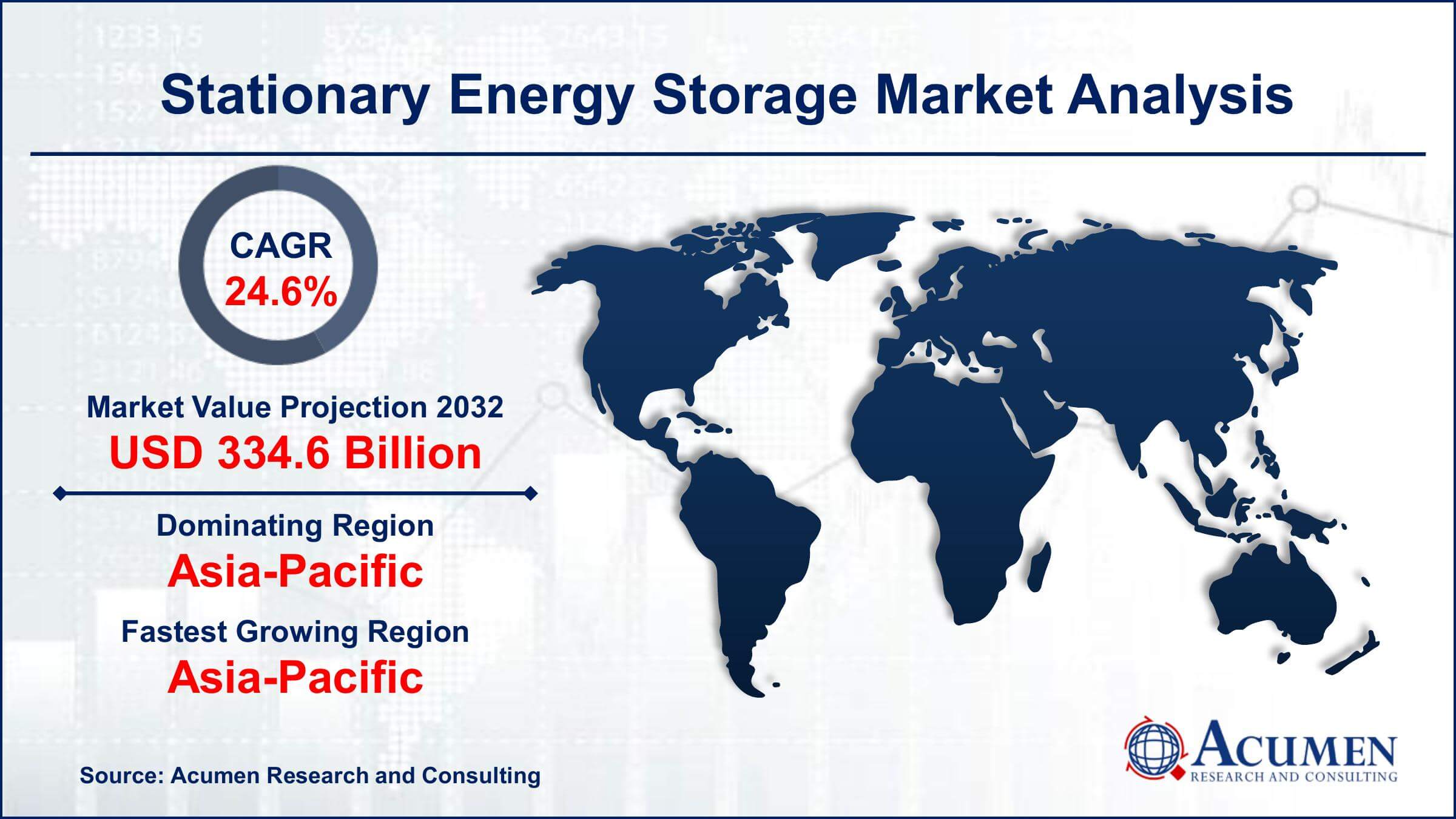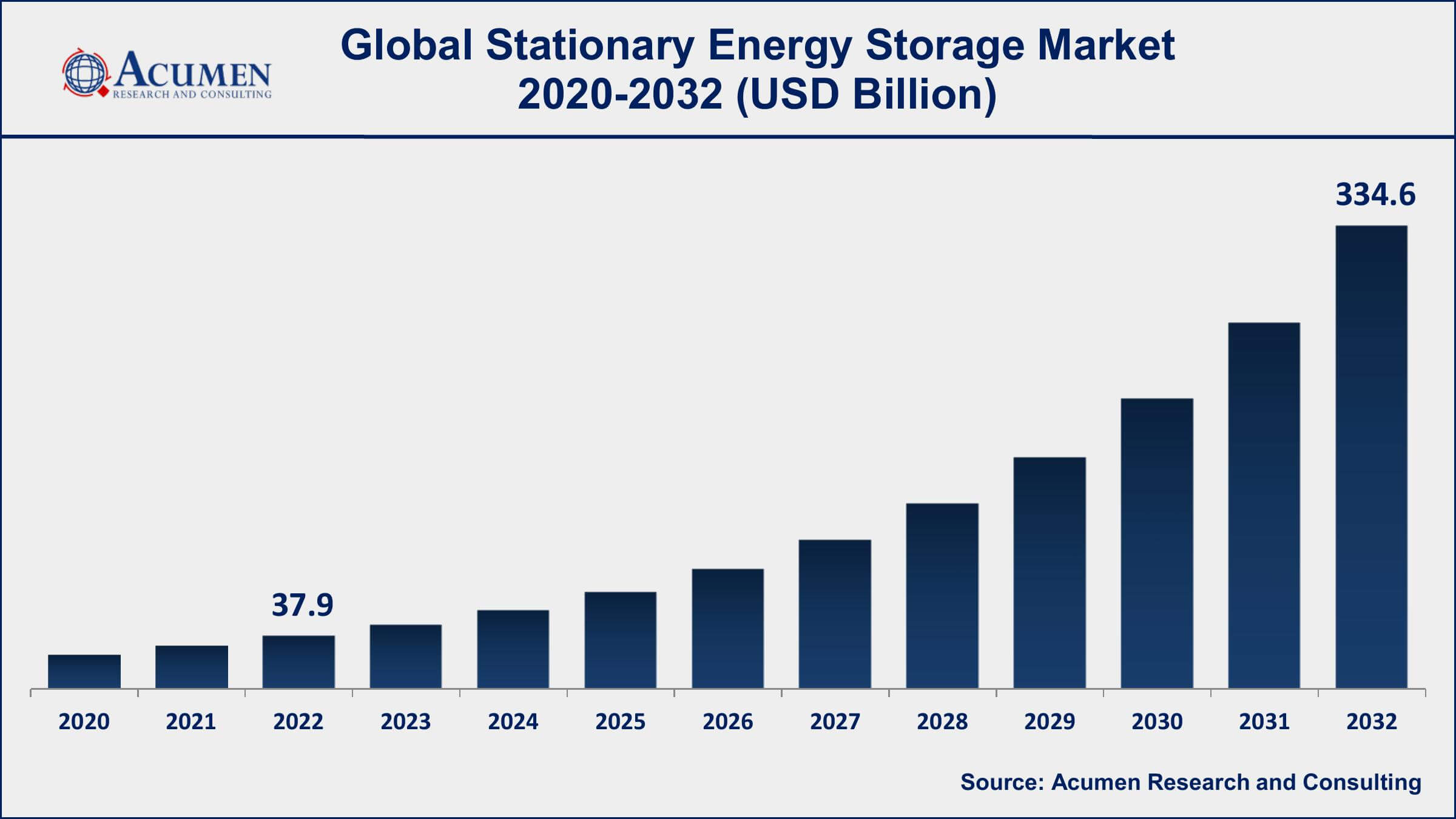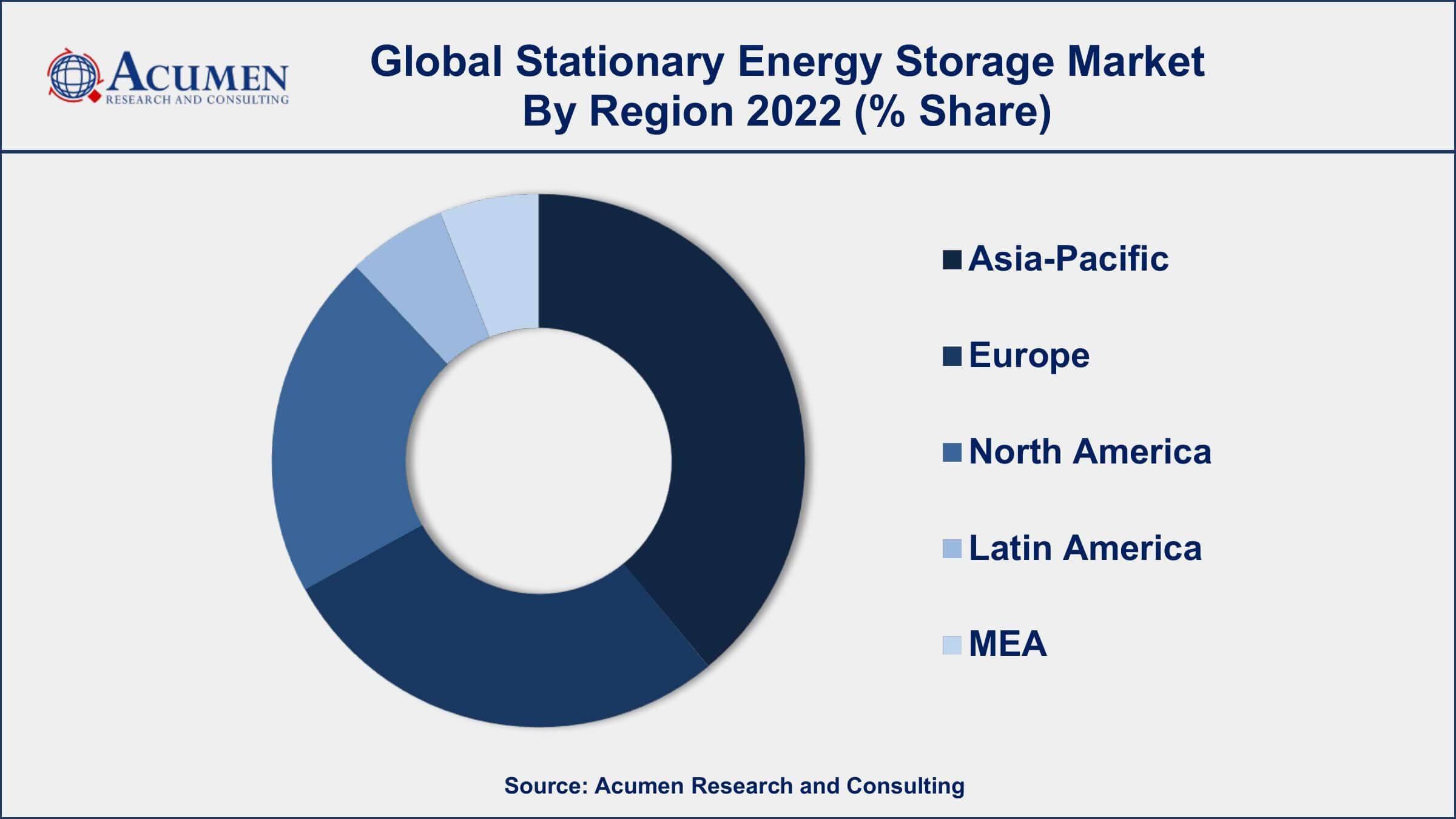February 2024
Stationary Energy Storage Market Size accounted for USD 37.9 Billion in 2022 and is projected to achieve a market size of USD 334.6 Billion by 2032 growing at a CAGR of 24.6% from 2023 to 2032.
The Global Stationary Energy Storage Market Size accounted for USD 37.9 Billion in 2022 and is projected to achieve a market size of USD 334.6 Billion by 2032 growing at a CAGR of 24.6% from 2023 to 2032.
Stationary Energy Storage Market Highlights

Stationary energy storage refers to the technology and systems used to store electrical energy for later use in fixed locations, such as power plants, commercial buildings, and residential homes. These storage systems play a crucial role in balancing the supply and demand of electricity, improving grid stability, and integrating renewable energy sources into the power grid.
The market growth of stationary energy storage has been significant in recent years and is expected to continue expanding at a rapid pace. One of the primary drivers of this growth is the increasing deployment of renewable energy sources, such as solar and wind power. As the share of renewables in the global energy mix grows, the need for energy storage becomes more critical to mitigate the intermittent nature of these sources and ensure a steady supply of electricity. Additionally, the decreasing costs of energy storage technologies, particularly lithium-ion batteries, have made them more economically viable and attractive for various applications. Another factor driving market growth is the increasing focus on grid resiliency and reliability. Stationary energy storage provides a range of grid services, including frequency regulation, peak demand management, and backup power during outages.

Global Stationary Energy Storage Market Trends
Market Drivers
Market Restraints
Market Opportunities
Stationary Energy Storage Market Report Coverage
| Market | Stationary Energy Storage Market |
| Stationary Energy Storage Market Size 2022 | USD 37.9 Billion |
| Stationary Energy Storage Market Forecast 2032 | USD 334.6 Billion |
| Stationary Energy Storage Market CAGR During 2023 - 2032 | 24.6% |
| Stationary Energy Storage Market Analysis Period | 2020 - 2032 |
| Stationary Energy Storage Market Base Year | 2022 |
| Stationary Energy Storage Market Forecast Data | 2023 - 2032 |
| Segments Covered | By Battery, By Energy Storage Type, By Application, And By Geography |
| Regional Scope | North America, Europe, Asia Pacific, Latin America, and Middle East & Africa |
| Key Companies Profiled | Tesla Energy, BYD Company Limited, LG Chem, Samsung SDI, Fluence Energy, Saft Group, NEC Energy Solutions, Panasonic Corporation, ABB, Siemens Energy, Hitachi, Ltd., and ESS Inc. |
| Report Coverage |
Market Trends, Drivers, Restraints, Competitive Analysis, Player Profiling, Covid-19 Analysis, Regulation Analysis |
Stationary energy storage refers to the technology and systems used to store electrical energy for later use in fixed locations. These storage systems are designed to provide a reliable and efficient solution for storing excess electricity generated during periods of low demand and releasing it during times of high demand. By storing energy, these systems help to balance the supply and demand of electricity, improve grid stability, and enable the integration of renewable energy sources into the power grid.
The applications of stationary energy storage are diverse and span various sectors. One of the primary applications is grid support and stabilization. Energy storage systems can provide frequency regulation, voltage control, and reactive power support, helping to maintain the stability and reliability of the electrical grid. They can also enable smoother integration of intermittent renewable energy sources by mitigating fluctuations in generation and providing backup power during outages.
The stationary energy storage market has been experiencing robust growth and is expected to continue expanding in the coming years. The market growth is primarily driven by the increasing deployment of renewable energy sources and the need for grid stability and reliability. As the share of renewable energy installations, such as solar and wind power, continues to rise, the intermittent nature of these sources necessitates effective energy storage solutions to balance supply and demand. This creates a significant demand for stationary energy storage systems. Additionally, declining costs of energy storage technologies, particularly lithium-ion batteries, have played a pivotal role in driving the Stationary Energy Storage Market growth.
Stationary Energy Storage Market Segmentation
The global Stationary Energy Storage Market segmentation is based on battery, energy storage type, application, and geography.
Stationary Energy Storage Market By Battery
According to the stationary energy storage industry analysis, the lithium-ion segment accounted for the largest market share in 2022. Lithium-ion batteries have become the preferred choice for energy storage due to their high energy density, longer lifespan, and fast charging capabilities. These batteries offer efficient and reliable storage solutions for a wide range of applications, including residential, commercial, and utility-scale projects. One of the primary drivers of the lithium-ion segment's growth is the decreasing cost of lithium-ion batteries. Over the past decade, there has been a remarkable reduction in the cost of lithium-ion batteries, primarily driven by economies of scale, technological advancements, and increased manufacturing efficiency. This cost decline has made lithium-ion batteries more accessible and financially viable for stationary energy storage applications, resulting in an increased adoption rate across various sectors. Another factor contributing to the growth of the lithium-ion segment is the expanding deployment of renewable energy sources, such as solar and wind power.
Stationary Energy Storage Market By Energy Storage Type
In terms of energy storage types, the hydrogen and ammonia storage segment is expected to witness significant growth in the coming years. Hydrogen and ammonia are emerging as promising energy carriers for long-duration energy storage, especially in applications that require high energy density and longer discharge durations. Hydrogen storage systems utilize electrolysis to produce hydrogen from excess renewable energy, which can be stored and later converted back into electricity through fuel cells or combustion engines. Hydrogen offers advantages such as high energy density and scalability, making it suitable for applications like grid-level storage, industrial processes, and transportation. The increasing focus on decarbonization and the utilization of hydrogen as a clean energy source are driving the growth of hydrogen storage solutions in the stationary energy storage market.
Stationary Energy Storage Market By Application
According to the stationary energy storage market forecast, the grid services segment is expected to witness significant growth in the coming years. Grid services refer to the range of functions and capabilities provided by energy storage systems to support and optimize the operation of the electrical grid. Energy storage technologies are increasingly recognized for their ability to enhance grid stability, reliability, and flexibility, leading to the growing adoption of grid services applications. One of the primary drivers of the grid services segment's growth is the increasing deployment of renewable energy sources, such as solar and wind power. Energy storage systems play a crucial role in mitigating the intermittency of these renewable sources by storing excess energy during periods of high generation and releasing it when demand exceeds supply. This enables better management of the grid's supply-demand balance, improves grid stability, and reduces the need for fossil fuel-based backup generation. Moreover, energy storage systems offer various grid services, including frequency regulation, voltage support, and peak shaving.
Stationary Energy Storage Market Regional Outlook
North America
Europe
Asia-Pacific
Latin America
The Middle East & Africa

Stationary Energy Storage Market Regional Analysis
Asia-Pacific is dominating the stationary energy storage market for several reasons, contributing to its leading position in the industry. Firstly, the region is experiencing rapid growth in renewable energy installations, particularly in countries like China, India, Japan, and South Korea. These nations have made significant commitments to increase their renewable energy capacity, driven by concerns about energy security, environmental sustainability, and the need to reduce greenhouse gas emissions. The integration of renewable energy sources, such as solar and wind power, necessitates robust energy storage solutions to mitigate their intermittent nature and ensure a stable and reliable power supply. The growing emphasis on renewable energy in Asia-Pacific has spurred the demand for stationary energy storage systems, driving the market's dominance in the region. Moreover, Asia-Pacific is witnessing significant investments and supportive government policies that promote energy storage deployment. Governments in the region are implementing favorable regulations, incentives, and financial mechanisms to encourage the adoption of energy storage technologies.
Stationary Energy Storage Market Player
Some of the top stationary energy storage market companies offered in the professional report include Tesla Energy, BYD Company Limited, LG Chem, Samsung SDI, Fluence Energy, Saft Group, NEC Energy Solutions, Panasonic Corporation, ABB, Siemens Energy, Hitachi, Ltd., and ESS Inc.
Looking for discounts, bulk pricing, or custom solutions? Contact us today at sales@acumenresearchandconsulting.com
February 2024
October 2018
August 2023
December 2024